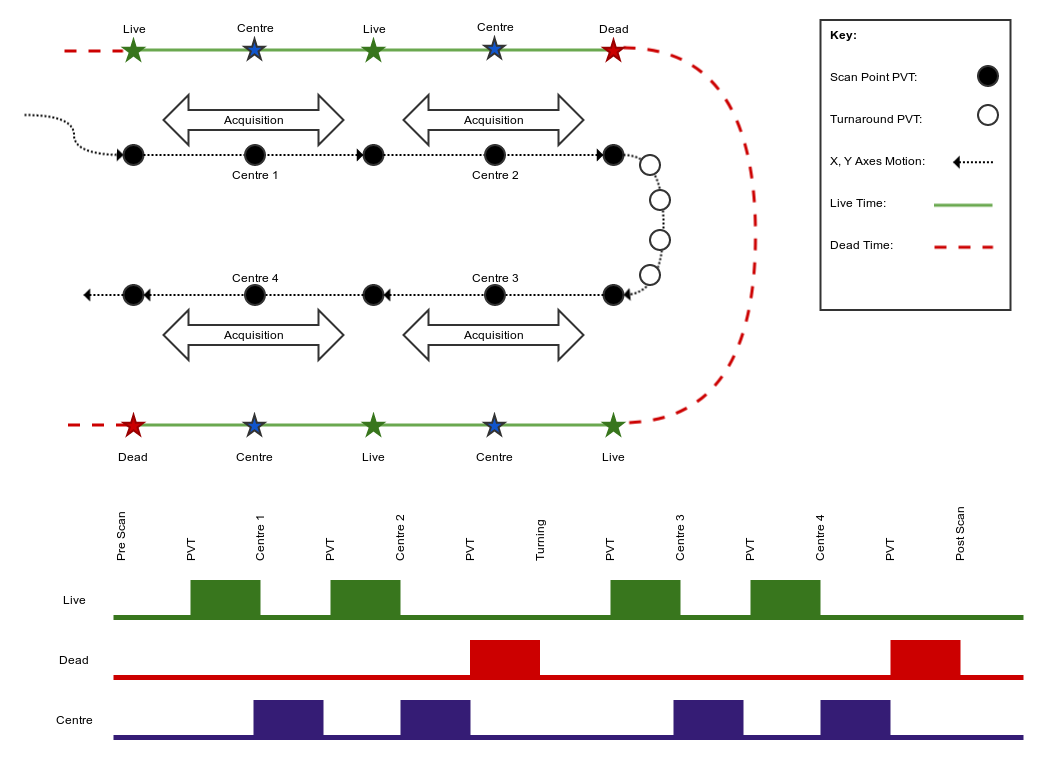Trajectory Scan Triggering
PMAC-based Triggering
This is intended as a description of how trigger signals are used and generated for a trajectory scan. It uses the DLS trajectory scan motion program for PMAC and Power PMAC. An example of this in use can be found in the PMAC Master Tutorial.
There are 3 GPIO signals used to provide triggering information for detectors. All of these signals are considered to trigger on a rising edge. They are all fed into a PandA which uses them to determine when to average motor positions and when to trigger the detector(s). The signals are :
Live signal: Indicates the start of a frame
Dead signal: Indicates the start of a period where no frames are acquired
Centre signal: Indicates that we are in the middle of the current frame
When a series of frames are taken back to back, the live signal triggers for the start of each. The dead signal triggers at the end of the last frame.
When Malcolm uploads lists of PVT points to the trajectory scan motion program it also uploads a User Subroutine to be called as each point is reached. The first 8 of these represent all combinations of the 3 GPIO Signals as follows:
User |
GPIO 0 |
GPIO 1 |
GPIO 2 |
|---|---|---|---|
Sub |
Live |
Dead |
Centre |
1 |
0 |
0 |
1 |
2 |
0 |
1 |
0 |
3 |
0 |
1 |
1 |
4 |
1 |
0 |
0 |
5 |
1 |
0 |
1 |
6 |
1 |
1 |
0 |
7 |
1 |
1 |
1 |
8 |
0 |
0 |
0 |
The diagram below shows an example of a snake scan with 6 data points and the corresponding trigger signals.
The graph at the bottom shows the states of the GPIO lines as the PVT scan progresses through its points.
Note that the acquisition time is shorter than the live time. The trigger signal for the detector is controlled by the PandA. In order to centre the acquisition with respect to the Live signals, the trigger signal can be delayed by half the readout time.
- Some of the PVT points are provided by Malcolm for convenience, and are used to:
Provide a centre frame signal, and
Tightly control turnaround path so that motors do not exceed their limits. The turnaround PVT points are added for locations where the acceleration changes.

Using the PandA for Triggering
The current PMAC devices at Diamond are limited to a maximum of 300Hz for the above signals. If this is exceeded, other processing on the PMAC will not have enough time to complete. It is, however, quite straightforward to set-up and use.
In order to use a higher detector trigger rate, the PandA can be used to generate the majority of the above signals itself. Using a single trigger signal to indicate the start of each row, it will trigger the detectors as well as position capture. The PandA Master Tutorial uses this method for triggering.
The start-of-row signal can be generated in two ways:
- PandA position compare
This requires straight through mapped axes (no kinematics)
This requires that turnarounds are more than 100ms, to provide enough time for processing
This has the benefit of making rows line up in snake scans if there is significant following error on axes
- PMAC row triggers
This can be used with kinematics
The row triggers have a maximum rate of 300Hz